I. Auguststraße
When I was asked to write about “Berlin in the nineties,” the quest for the “postcapitalist self,” and the idea of “queering the economy,” my gut idea was to contribute a text titled “How We Fucked It All Up.” But I soon realized that in this particular context, the term “we” was rather problematic, and might have further confused a discussion that seemed to me quite conceptually precarious already. This context is not just the highly heterogeneous mesh of critical initiatives in and around art and politics as they existed in Berlin around 1995 (whose highest virtue, in retrospect, may have been their fierce mutual ignorance), but also the Berlin Biennale of 2010, and the fuzzy sense of place, time, and bedfellowship it seems to generate among its participants and audiences. So I decided to bet on the first-person singular with the hope that this person is not so deeply invested in the history that is being rewritten here.
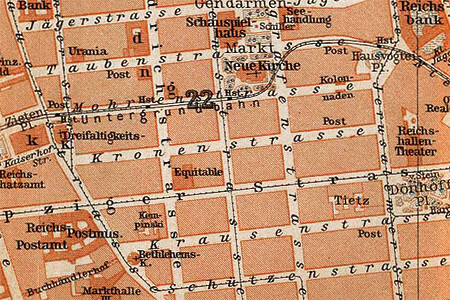

II. Kronenstraße
I moved to Berlin in early 1994. Even though friends who came earlier, whether in 1979 or 1991, would have argued that everything was over by then, Ariane Müller, who moved in one year later, recently reminded me that it was still a period in which one would never leave the city for more then ten days, since so much was happening that it would have been impossible to catch up on any of it. And I realized that this was an accurate description, not just a shared illusion, since not only did I recall having the exact same impression, but I also knew that I didn’t know her back then, and was doing entirely unrelated things in completely different fields. I only realized much later that I had been surrounded by artists the whole time, but had simply mistaken them for people running bars, since, after all, that’s what most of them were doing. It didn’t take long to develop a precise and irreversible sense of what a club should be like. The only door policy was finding the door, audiences were mostly domestic and regular, the producer/consumer hierarchy had been flattened to the difference in height between a bar and a bar stool, a popular misreading of Deleuze and Guattari had led to the abolishment of all stages, and while one would rarely enter a conversation that didn’t go somewhere consequential, there was hardly any business to be done, since what was being sought and offered in these places was transparency, much more than distinction.
III. Mauerstraße
I’ve thought about this configuration a great deal recently, when thinking about cities in Southern and Western Asia, the few artist collectives there, the even more unlikely non-elitist and self-organized ones, the rare attempts at creating spaces just for themselves, the instant international recognition they get from curators, the predictable way in which the first biennial usually tears them apart, the irreversible centrifugal energy when they partition (typically along the lines of class, caste, gender, or passport) into frequent and not-so-frequent flyers, and how fortunate, in contrast, the situation had been in Berlin in the nineties, when a few people got a bit of time, and space, to just find out and repeat and refine what they were doing, on their own terms. (As Godard said about the Nouvelle Vague: We were just three or four people who spoke with each other, but that was enough to make a difference, to give us a lead of about half a year, and this lead we would always retain.) Not only were there no curators, there wasn’t even any press yet. Word had it that pop music and youth culture were dead, but the German feuilletons had so far been unsuccessful in locating their corpses. Those were the days, and the crackers at Universal weren’t even playing yet.


IV. Unter den Linden
Like many West Germans, I had moved to Berlin to “go to university,” which didn’t mean to go to university much, and I never went back after the student strike of 1997–98, when my fellow students turned from ghosts into zombies, proudly mobilizing what they thought were their memories of past revolts, while all they had in mind was to demand more efficiency from the collapsing educational bureaucracies. This was at a time when Pisa and Bologna were just cities in Italy. I spent half a semester trying to write a text that would top “On the Poverty of Student Life,” and then, since getting anything larger than an MP3 online was still not practical, went on to produce a three-hour VHS version of “The Society of the Spectacle,” in full ignorance of the original film. While, in retrospect, the remake included a number of close matches, and maybe even the occasional improvement, I don’t feel much nostalgia for the futile exercises of the pre-Napster era. The internet was slowly getting better (even though everyone was busy lamenting the sellout to the dot-coms), Nettime had become the most splendid academic ad-hoc network on the face of the planet, and with regards to local brick-and-mortar institutions, there were still enough bars, clubs, and storefronts that no university would have had the means to compete with them.


V. Zionskirchstraße
In the mid-nineties, I moved from Schöneberg to Prenzlauer Berg to Mitte, and the streets on which fifteen years later Germany’s most admired moms would form Europe’s most famous pram jams were still grey and deserted. The typical occupancy of a residential house consisted of alcoholics on the bottom floor, students up to the third, and old couples on the fourth, eagerly awaiting their displacement to suburban housing blocks with functioning elevators. The general mood was decidedly pre-capitalist, and it was a widely held belief that what Berlin was experiencing was not gentrification, but gentrification envy. When the first Charlottenburgers set foot in the eastern districts, and Prenzlauer Berg’s very first young mother was spotted navigating a stroller filled with fresh vegetables around the holes in the pavement, their appearance was regarded as a curiosity, even though it was clear that they were harbingers of the future, and that in the long run, the dead-end logic of nostalgia would take over. What most young West Germans remember about old East Berlin are endless winters, coal heaters, toilets on the stairs, phone booths on the street corner, and supermarkets filled with nothing but beer, and still today, one can occasionally see them standing on their rooftop terraces, assuming a pose in which they resemble their grandfathers reminiscing about World War II, pointing at the surrounding neighborhoods, and proclaiming: This was all ours!
VI. Sebastianstraße
The continuous demand for authentic accounts from post-Wall Berlin tends to obscure the fact that “Berlin in the nineties” forms part of a larger cyclical development, and that its appellation performs a specific function within that cycle. There is also “Berlin in the eighties” and “Berlin in the seventies,” or, to be more precise, a progression, or regression, that moves from Charlottenburg to Kreuzberg to Mitte, with Schöneberg and Friedrichshain as transitions. And if we zoom in closer, we can make out a variety of different camps as they move towards, and past, their very own mythical ending points (the commodification of heroin, the death of Klaus-Jürgen Rattay, the fall of the Wall, the eviction from Mainzer Straße, the 1995 Venice Biennale). When evoking memories of Mitte in the nineties, one should be careful not to reconstruct as a continuation, evolution, or refinement of the eighties in Kreuzberg what was for many, not just on a symbolic level, their erasure. Nor should it be conveniently ignored that while the inhabitants of Kreuzberg had succeeded in creating resilient critical infrastructure and sustainable autonomous economies, the population of Mitte almost completely failed at that, despite some rather ambitious attempts. One might try to argue that the highway intersection that would have been Kreuzberg in 1980, just like the high-rise ghetto that would have been Friedrichshain in 1990, never made much sense economically, while turning Mitte into a shopping mall by 2010 did. But this argument doesn’t take into account that the perceived economic potential of specific instances of city redevelopment is often a direct result of the means that are brought forward against them. Even the much-lamented “strategy” of recuperation through co-optation is a messier process than most of its critics believe, as it will usually be initiated as a very last resort, and may face stronger resistance among other recuperating forces than from their opponents.
VII. Oranienplatz
If the quest for less capitalism, or at least fewer capitalist subjectivities, means not just to make forward-looking statements, but also to catalogue what has been done, to make a map and a graph of intensities, then I’m actually pretty certain—though I have to derive my estimate from a relatively small number of data points that are mostly just short and distorted blips of third-hand knowledge acquired from very untrustworthy sources—that with regards to the art of not being governed that much, Berlin peaked between 1980 and 1982. Even though it has to be acknowledged that a mostly deserted inner-city district came into view ten years later behind the fallen Wall, where it was practically impossible to establish ownership of property. After all, the Police were driving around in Ladas, and the first impression among early explorers of this district must have been of not being governed at all. This was less of an art, though, and more of a gift, and turned out to share a couple of blind spots with the surrounding frenzy of German reunification concerning the redistribution of property. Once the “Jewish Community” of Berlin had been reconstructed as a few blocks of kosher but judenfrei Disneyland, and West Berlin’s anti-squatter police had established a rudimentary understanding of their rules of engagement, most property disputes could be settled consensually, among equals. Even though this process sometimes took a bit longer than initially expected.
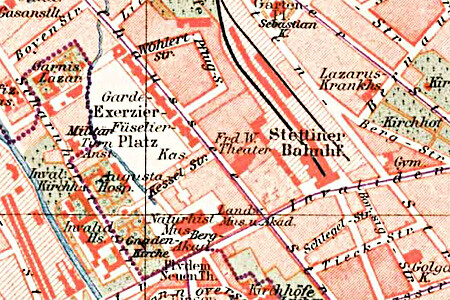

VIII. Chausseestraße
In 1997, one could make out a general consensus (among those who had moved to East Berlin in the previous five years) that the party was about to be over. Potsdamer Platz was going up, the federal government was coming in, and both Hamburg and Cologne had given up their resistance, surrendered to their fate, and were relocating their critical infrastructure to Berlin. (Only Frankfurters came without a sense of defeat. To figure out why is left as an exercise for the reader.) But while the city stood in awe, anticipating the heavily promoted “rebirth of a metropolis,” the new millennium announced itself with the burst of the dot-com bubble and the collapse of the New Economy, tightly followed by the disintegration of the old economy, the banking scandal, the city’s indefinite bankruptcy and its hasty rebranding as “poor but sexy” (which may have been the closest to “post-capitalist” and “queer” that the city’s popular self-perception could have ever become). But while the prospect of yet another decade of “interim use” of empty office buildings, this time equipped with state-of-the-art facilities, sent waves of joy throughout the cultural sector, the rules of the game were slowly beginning to change. Just as it needed a Social Democrat/Green federal government to dismantle the German welfare state, it took a Social Democrat/Socialist city senate to finally abolish the planned economy that, since World War II, had been practiced in both halves of the city. As the long-bankrupt city sold off massive amounts of formerly affordable housing to soon-to-be-bankrupt pension funds, the economically backward parts of the population began to realize that they were actors in a market too (even though in that market a pension plan had become, essentially, a bet on losing one’s own home). And ironically, by officially marketing its poverty as sexiness, Berlin had tapped a gold mine. The recent explosion of low-end tourism may in fact be the first market-driven boom cycle that any Berliner alive today has ever witnessed.
IX. Saatwinkler Damm
Today’s situation has been analyzed with varying depths of field, but its basic parameters should be evident not only to long-time residents, but to the most casual observers. While half of the Western European middle class under age 35 seems to be roaming the streets of Berlin, busy figuring out if they are on holiday or staying, renting or buying, joining the creative industries or just spending money (establishing social norms and cultural habits in which I find processes of “queering” and their very opposite increasingly difficult to distinguish), most of the people I would want to be in a continuous conversation with only have a rather discontinuous presence in the city, since the infamous Berlin Economy has made them take on jobs or teaching positions in the exact same places on the European periphery from which the exodus to Berlin is originating. And of course, I haven’t been around here that much either, and have caught myself more than once, lately, walking home at night after a long absence, thinking for a moment how convenient it is that my hotel is in such a central location. Still, friends who come to Berlin from faraway places keep on insisting that anything cultural here still attracts the best audiences in the world, and, in fact, it can be astounding to return to a city where one may still occasionally encounter, at 2 a.m. and in the most unlikely locations, hundreds of people with enough time on their hands to be discussing art or politics, without necessarily having any personal investment in either.
X. Rosa-Luxemburg-Straße
After sixteen years in Berlin, I have no job, tax number, welfare benefits, pension plan, health insurance, credit card, savings, or functioning mailbox. Some of it happened by choice, some more by accident, and while it wouldn’t be too hard to lay out a postcapitalist politics in which most of these missing achievements would appear as the fortunate and desirable results of a set of precisely defined strategies, I’m still aware of the fact that whenever an item on the list becomes critical, it typically presents itself as the individual disaster that is capitalism, rather than the collective crisis that would get anyone beyond it. This may be due to the fact that most of the relations I maintain, and the networks I participate in, would have to be described as either “private” or “professional,” and not as “political,” however politicized this semi-public privacy or half-amateurish professionalism may appear to its respective protagonists. I’m relatively sure that this is a common problem, and that the root cause of most people’s existential panic when they reflect on their own biographies is that they have zero friends with whom they would have entered binding agreements to abolish the capitalist mode of production. Yet in a very practical sense, being relatively unattached to the state and its organs, while still being thrown cultural funding in varying quantities and irregular intervals, makes one surprisingly mobile. This can be dismissed as another essential requirement of our post-Fordist age, but comes, at least for holders of European passports, with the privilege of being offered some occasions to temporarily decenter one’s most general perception of things. The most hopeless aspect of European politics is the point of view (not the political orientation, but the perspective on the world) of its protagonists.
XI. Kottbusser Tor
Over the past few years, I have partially outsourced myself to Bombay, which is not necessarily the most welcoming city in the world, and may have seen better times, but through its sheer density still manages to provide its inhabitants with a faint sense of the beauty that can arise from collectivity (even if through its negative aspects, the brutality and corruption that usually arise). Having seen different flavors of misery, I think one should be very reluctant to claim, or make arguments based on the assumption, that things are always more miserable elsewhere. German welfare, aptly named after a corrupt union leader (Peter Hartz), comes with drinking water, a separate pipe for the toilet, and a thoroughly perfected form of sensory deprivation that the majority of the eight million slum dwellers of Bombay would not want to endure for very long. A dense social fabric creates its specific needs and habits, and they tend to be extremely hard to break, so that even in Bombay—one of the most rapidly changing cities in the world, whose permanent destruction is carried out with breathtaking efficiency—the relocation of the poor to the periphery is expected to take much longer than in Berlin, despite memories of individual rights and collective struggles, and a long history of fuckups and delays in implementing capitalism. At the same time, one should be just as reluctant to claim or build one’s politics on some fictitious common ground among the multitudes of the disenfranchised and unmodernizable, since beyond their fanatic devotion to their respective national sports, they may only converge over their deep resentment of everything foreign, glamorous, or just remotely cosmopolitan.
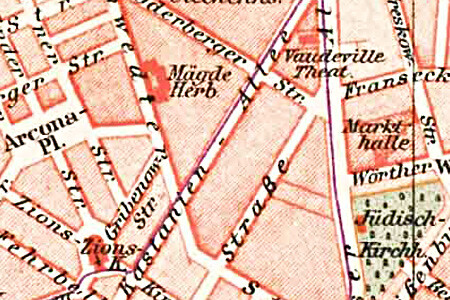

XII. Kastanienallee
Since, for many Europeans, Dubai, Delhi, or Shanghai have replaced New York or Los Angeles as the primary destinations of their educational journeys, some of them have come to acknowledge that while what they are confronted with in these places no longer looks like the capitalism they used to know, the entirely different set of differences it produces seems to render their notions of “post-capitalist selves” all the more precarious. Even if they have given up on the idea of “selves,” and are on the quest for post-capitalist others, they might be looking for them in all the wrong places. As a friend from Bombay once warned me:
You’re here because you’re subculture. Otherwise, you wouldn’t have come. And I’m talking to you because I’m high culture. If I weren’t, we wouldn’t have met. Now we can team up and try to find some subculture here, but if we find it, which we most certainly won’t, we’d probably both wish that we hadn’t.
Personally, I have a growing suspicion that what we commonly call post-capitalism is still as capitalist as post-socialism is socialist or post-colonialism colonialist (the latter should be instantly evident to anyone who has ever been on the receiving end of the “international collaborations” or “intercultural exchanges” that governments, NGOs, and philanthropists have devised for the “developing nations”), and may be just a more endangered, inconsistent, radicalized, and efficient form of capitalism (to call it “queer capitalism” might still be too polemical).
XIII. Sophienstraße
I have never used the word “queer” much, having disregarded it as a fashion phenomenon, for being most popular among the straight and the square. Just like some people choose to live on the edge of a slum, even though they could afford a better place, which may seem strange until one realizes that they are going through a phase of investment, that their straightness has to pass through something queer in order to come out even straighter. (This edge of the slum, and who would ever try to see more than the edge, is also where the slum looks most miserable.) If “queer,” as a verb, simply refers to various practices of “ontological reframing,” the acknowledgement of individual constitutions that can no longer be captured by identity, and collective processes that escape the dominant mode of production, then I may be able to relate to it. But when “queer,” as a verb, comes in the form of an imperative, it seems to call for a more refined perception of difference rather than for improvements in its production, and the former appears to often be coupled with the secret or outspoken desire to relegate the latter to a determinedly nondeterministic universe of hives, flocks, swarms, and molecules (this may well be another fashion phenomenon). But that’s not where I live, or would ever want to, and I would insist, when making these maps and timelines of what escapes, upon a minimum of causality and historicity. I am where I am by choice, not necessarily mine, but maybe the choice of a few songwriters who forty years ago wrote a couple of songs that twenty years ago I spent a few months listening to, in combination with one or two books that made me read fifty more. I have always found the concept of “points of no return” much more appropriate than the idea of “queering,” and even though I see that it has specific disadvantages (the lone heroism of punctuation, the imminent danger of getting lost), the commitment to irreversibility that it entails not only makes it less susceptible to commodification or silent corruption, but also, and more importantly, provides a somewhat meaningful and stable definition of “post.” Which could be useful, just as it dawns upon us that the most advanced form of capitalism may be the one that is the most tightly interlaced with the fluctuating pathways of allegedly post-capitalist selves.
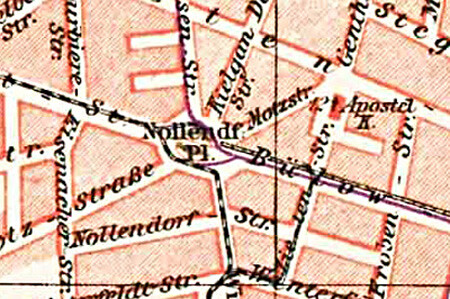

XIV. Nollendorfplatz
It must be noted that not too many of the above-mentioned points of no return would have offered themselves up without the secret cultural dominance of the minoritarian Left in the eighties, and the autonomous infrastructure it had at its disposal. It was always evident, even in the most conservative surroundings, that the most attractive others were to be found, or to be seduced, by moving to the most radical position on the Left. And while most infrastructure has been lost since then, and most secret knowledge, or cultural agency, has long dissolved into the mainstream, the basic logic of seduction through radical anti-capitalism turned out to be astonishingly resilient. And it was probably the strongest asset of the radical minorities (after all, one doesn’t fall out of love with capitalism through movies, books, and music alone), and the one that would always allow it to keep the majoritarian, organized, traditionally “political” Left at a distance. In the course of the last twenty years, though, it has become obvious that we’re looking at a transient phenomenon that was part of a rather specific historical configuration (the “age of youth,” postwar capitalism’s production of an overeducated but underemployed generation with disposable income and a refined interest in cultural products and social relations that promised to transcend their own commodity form), and cannot be generalized across time and space.
XV. Brunnenstraße
The question of infrastructure that allows for escape, and of institutions that provide the requisite seductive qualities, still remains. Since radical political movements, and what they maintain as their “culture,” have lost their momentum, many hopes seem to rest on the arts. At the same time I can sense, among many of my non-artist friends, a well-established hatred of the arts, profound enough to remain relatively constant through the recent cycles of boom and bust. There may be various reasons for this. Maybe the last thing in art history they took notice of were the Situationists, and they’re stuck with an unqueered Hegelian notion of the arts and their abolishment, such that their continuation must be majorly irritating. Or they might perceive contemporary art as just another hostile business, the sister sector of real estate and mass tourism, at the forefront of “global cultural asset management,” which wouldn’t be all that wrong. If it turned out to be mere resentment of its escapist tendencies, the mildly decadent reality of international flights, free dinners, and surplus value created out of thin air, then we might have a problem. What I personally resent, as it marks an irreversible political shift, much like the fall of the Wall, is the transition from music to art as the core cultural coordinate system of German society. Music, as Leitkultur, was democratic. The arts are feudal. If you dropped out of school in a provincial town, you still had access to the system of music. The system of the arts doesn’t even grant access to the majority of Berlin art students. And while the rapidly changing macroeconomic conditions make it increasingly attractive to seek refuge among the entourage of kings, collectors, and gallerists, rather than to depend on the state, or its abolishment, it’s even obvious to most of its secret admirers that feudalism doesn’t scale very well.
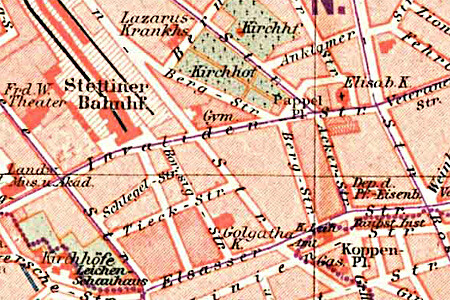

XVI. Invalidenstraße
Within its limited scope, though, the system of the arts has, over the last decade, provided a series of openings through which it was able to not only attract a large number of selves, but also successfully absorb extensive slices of neighboring fields, most notably in the former educational sector. And while, thankfully, you still don’t need a PhD to participate in a biennial, the fact that the first biennials are getting into the business of granting PhDs has to be read as a glaring symptom of crisis. Most generally, a system that accelerates its rate of expansion and absorption to a point where its entire functioning becomes dominated by, and dependent on, the imperative to radically open, will self-destruct rather promptly. In this context, it is relatively unsurprising that, among my artist friends, there seems to be an increasing pressure to produce less art and undertake more curatorial activities. Since what makes the figure of the curator so attractive (as a role model, it has long surpassed the figure of the artist in desirability) is the fact that while the work of the artist, as much as it has been reduced to communication (the establishment and maintenance of a continuous presence on Gmail and Skype), still has to include the occasional production of art, the work of the curator promises to consist of nothing but communication. And this widespread desire to produce less and network more can’t be so easily dismissed as a matter of ideological confusion, since the crisis it articulates, not just in the arts, is an actual and material one.


XVII. Gendarmenmarkt
The macroeconomic and macropolitical developments of the last two or three years are hard to ignore, and call for a major re-evaluation of the microeconomic and micropolitical strategies and practices that we understand as “postcapitalist” or “queer.” We are beginning to realize that we may actually see the end of capitalism as we knew it, not just at its peripheries, but also at its core, and not just in our lifetime, but likely in the coming decade. But just as it is conveniently claimed that the current financial system is “beyond anyone’s understanding,” there is a lack of descriptive or predictive concepts for the political formations that will emerge. As capital in its most recent stage—as a global pyramid scheme of debt and bailouts that is deemed “too big to fail”—is in the process of reducing the political sovereignty of most nation-states to merely ceremonial functions, the political reassessment (if not ontological reframing) taking place in the “developed world” offers a view to a future that looks much more post-democratic than it looks post-capitalist. With regards to the art of not being governed that much, the declining influence of national governments and democratic institutions, and the increasing difficulty they encounter in justifying their existence, may appear beneficial. Yet it seems more than likely that the impending collapse of a number of global systems and networks is going to thoroughly and lastingly stratify the queer or post-capitalist subjectivities as we knew them, since hardly any of them have ever ceased to be middle class, however precarious their material existence may have become. As capitalism manages to still provide a minimum of welfare and mobility to some of its participants, they remain invested in the delay, rather than the acceleration, of its decline. Most of the subjectivities in question still see the world from Europe, after all.
XVIII. Kantstraße
One might still ask what’s to be done. If you can’t subvert an empire whose population draws no immediate benefit from any redistribution of wealth other than the one that is currently taking place, you may still be able to crack the fortress that shields its inhabitants from a shift in population growth that will inevitably shake the fundaments of their lives. (Europeans tend to condemn their borders in solidarity with non-European migrants, but in the long run, this relationship will reverse. Those outside the fortress will have the privilege of forgiveness. Those inside won’t.) If you are a citizen of the Schengen subcontinent, you can do two things, both of which involve making use of the one biopolitical weapon you have been equipped with: your passport. Either get married so that someone else can get in, even if it’s just for a temporary change of perspective; or quit and desert your compatriots, as their biological clocks keep ticking in fearful but eager anticipation of the detonation of the demographic bomb. Collective suicide is not an option. Still, if you set out to be done with Europe, there is an imminent danger that you will remain caught within the schizophrenic logic of a post-capitalist self, and doomed to relive the farce of European subjectivity, its quest for an exit, as yet another Greek tragedy. What you might need most urgently, in order to complement the anti-Oedipus, would be the anti-Midas, since wherever you’re going to end up, you won’t want to forever remain a member of the classes that turn everything they touch into shopping districts.
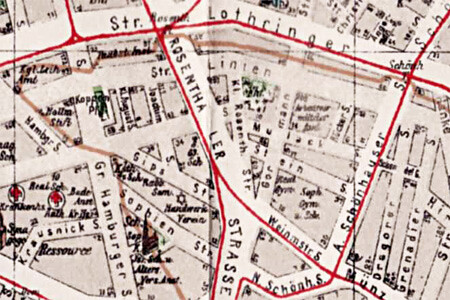

XIX. Rosenthaler Platz
And finally, since Guy Debord (“The Sick Planet,” 1971) and the Club of Rome (“The Limits of Growth,” 1972) published their reports on the final frontier of the market economy, we know that we are living in a stage of capitalism that produces, above all, a rapidly accelerating ecological disaster of planetary scope, which threatens to preempt any meaningful notion of “post-capitalism” by making it synonymous with global apocalypse. It will be crucial to reclaim the question of ecology from the post-conservative, post-colonial movements that have monopolized it for the last thirty years and turned it into a matter of “having borrowed the planet from our children,” as it became popular among the children of the capitalist elite whose prospects of future profits capitalism had begun to undermine. The question of ecology is, essentially, the question of pollution and waste, and almost all aspects of today’s pollution of the environment and waste of its resources are the direct result of the most fundamental type of waste that the capitalist mode of production produces, which is the waste of time. Not only does the waste of time pollute the environment, it also produces the forms of subjectivation that are required to inhabit a world of waste as one’s natural habitat. Cars don’t primarily pollute by producing carbon dioxide, but by producing streets, and separation. Fatal diseases don’t just spread with the pollution of water, but with its commodification. Most emissions remain harmless until they can be traded on a global market. And so on, the list of basic banalities that must remain complete mysteries is long and gets longer, as long as the dominant ideology of “ecological consciousness” means to vigilantly defend some inconvenient truths, be it the greenhouse effect or the survival of the fittest, while conveniently remaining in denial of capitalism.
XX. Platz der Vereinten Nationen
When I had the immense privilege of watching Europe from the outside as it disappeared under a volcanic cloud—an “ash signal” from one of the first post-capitalist microstates in the region, a people who chose to be relegated to the status of subsistence fishers rather than sell out to the failing financial institutions of the European Union, which were then scrambling to protect their investments in the failing airlines (I heard that the streets of Berlin were almost deserted, while the sky over the city was clear for the first time)—I couldn’t help but smile. What had become conceivable again was the planet, as something other than the globe of the capitalist market, the toxic remainder of capitalist production, or the domesticated natural reserve of capitalist ecology. There’s more to climate change than global warming, fear of frequent flying, or the fear among most Europeans that their impending failure to sell another hundred million oh-so-eco-friendly cars to China will immediately result in a hundred million drowning or starving Bangladeshis. None of whom, of course, they have ever met or spoken to—whether out of political principle or as a simple matter of politeness—in order to discover the possibility that they could be doing just fine, just like all the other imaginary others of the capitalist self, and that the climate might just as well change in their favor.



